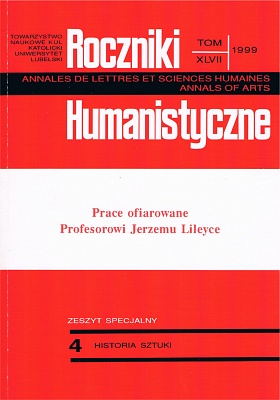Początki latynizacji architektury greckokatolickiej na Białorusi: cerkwie w Mirze i Nowym Świerżniu
Abstrakt
One of the most interesting phenomena in the architecture of East Europe is latinisation and occidentalisation of Greek Catholic (Uniate) Orthodox churches. The beginnings of this phenomenon have not been taken up by researchers up till now. The founders were advocates of the new form of Orthodox churches. They were often involved in the process of integration of the Eastern and Catholic Churches. One of them was Mikołaj Radziwiłł “Sierotka” (“Orphan”) who took part in preparations of the Union of Brest and in signing it in 1596. In the years 1586-1616 the Duke founded at least four Uniate Orthodox churches built on the territories of contemporary Byelorussia, among others in Nieśwież, Nowy Świerżeń, Mir and Łachwa.
The St George Orthodox church in Nieśwież was built in the years 1586-1596. It was established on an almost rectangular plan with four round turrets in the corners. The main part was covered with a ridge roof with a dome in the middle and the turrets were also covered with cupolas. Its shape was similar to the local Orthodox churches (Połock, Brest, Supraśl, Synkowicze, Małmożejki). The Orthodox church in Nowy Świerżeń is built on a plan of a long rectangle and it has a tower façade. The plan and the shape are derived from Catholic architecture.
The Holy Trinity Uniate Orthodox church in Mir was built on the plan of the letter “T” whose crosswise arm is joined to a deep, semicircular apse. The width of the crosswise part corresponds to the length of the nave. The brick Orthodox church built at the beginning of the 17th century in Łachwa has a similar plan. The architectonic form of the Orthodox churches in Nowy Świerżeń and Mir was defined by the Catholic founder – Radziwiłł the “Orphan” and the Jesuit architect Giovanni M. Bernardoni.
The Orthodox churches in Mir and Nowy Świerżeń built at the turn of the 16th century are the earliest examples of Greek Catholic church architecture on the territories of the Grand Duchy of Lithuania in which the phenomena of occidentalisation and latinisation occur.
Copyright (c) 1999 Roczniki Humanistyczne

Utwór dostępny jest na licencji Creative Commons Uznanie autorstwa – Użycie niekomercyjne – Bez utworów zależnych 4.0 Międzynarodowe.





